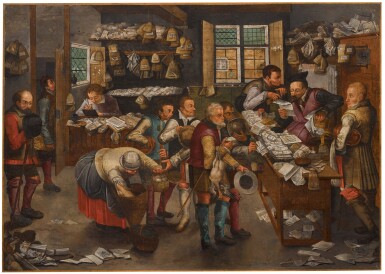
Property from an English Private Collection
Pieter Brueghel the Younger
The Village Lawyer's Office
Lot Closed
December 5, 02:27 PM GMT
Estimate
20,000 - 30,000 GBP
Lot Details
Description
Property from an English Private Collection
Follower of Pieter Brueghel the Younger
The Village Lawyer's Office
oil on panel, transferred to canvas
unframed: 74.5 x 104.2 cm. 29 1/4 x 41 in.
framed: 93.5 x 123.4 cm.; 36 3/4 x 48 5/8 in.
This composition by Pieter Brueghel the Younger proved to be one of his most popular. Known in numerous versions, of which some twenty-five are considered autograph, the earliest dated version is from the year 1615.1 Brueghel and his workshop produced the composition in two sizes: the smaller format measuring approximately 55 x 87 cm., and the larger format, such as the present example, measuring approximately 76 x 123 cm.2 The overall design was presumably transferred from a tracing and so remains largely the same in the various versions; the caricatured faces remain consistent and the overall scene displays Brueghel’s unique talent for narrative detail. The extant versions of the composition fall broadly into two main groups: those with woven straw matting on the rear wall of the office, with dated versions falling between 1615 and 1617, and others with a dark cloth, as here, the dates of which range from 1618 to 1626.
Though traditionally this work has been variously titled The Tax Collector’s Office, The Payment of Tithes, or Rent Day, it is more likely to depict a chaotic and busy village lawyer’s office.3 An inventory of a collection from as early as 1627, for example, describes a painting on panel by the younger Brueghel as depicting een franschen procureur (a French Lawyer).3 Many of the papers, including the calendar on the right hand wall, are indeed inscribed in French, which was the lingua franca used for legal documents in the Netherlands. Unusually the source of the composition is not the work of the artist’s father Pieter Bruegel the Elder (1525-69), nor any of his contemporaries such as Marten van Cleve (1527-81) or Peeter Baltens (1527-84) and may be an invention of Pieter Brueghel the Younger himself. Klaus Ertz has proposed that the source may be a work by the French painter Nicolas Baullery (1560-1630).
Brueghel’s design depicts a crowded scene as peasants line up for the services of the lawyer, who is seated behind a paper-laden desk wearing the traditional cap of his profession. They have brought produce – bunches of grapes, dead fowl, a basket of eggs – to offer as payment, while others appear to be anxiously awaiting decisions.4 The caricature-like representation of figures may well have been intended as a means of satirising the legal profession. An engraving made after the composition, for example, was published in 1618 by Paulus Fürst for a pamphlet denouncing the corruption of lawyers, which no doubt provides a clue as to the enduring popularity of the composition.
1 See K. Ertz, Pieter Brueghel der Jüngere (1564-1637/38). Die Gemälde mit kritischem œuvrekatalog, Lingen 1988/2000, vol. I, p. 501, cat. no. 489, reproduced.
2 See C. Currie and D. Allart, The Brueg[H]el Phenomenon, Paintings by Pieter Bruegel the Elder and Pieter Brueghel the Younger with a Special Focus on Technique and Copying Practice, Brussels 2012, vol. II, p. 672.
3 See D. de Vos, Stedelijke Musea Brugge, Catalogus Schilderijen 15de en 16de eeuw, Bruges 1979, p. 95.
4 For taxation purposes, grain would have been a more common currency. See N. Davis, The Gift in Sixteenth Century France, Oxford 2000, p. 260, n. 3.
You May Also Like










